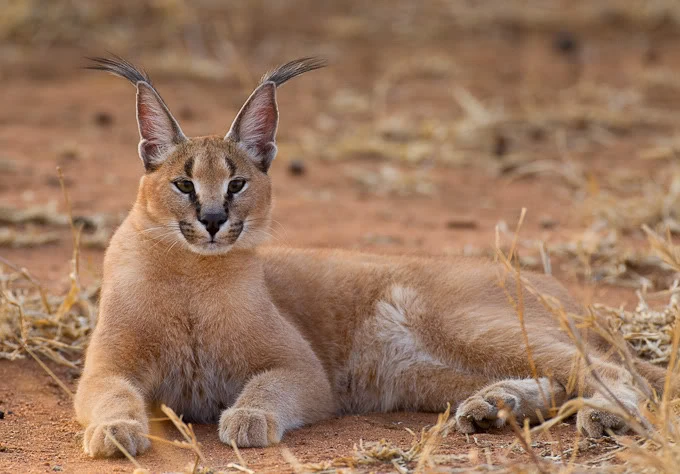Post by dinosauria101 on Aug 16, 2019 16:57:08 GMT 5
Caracal - Caracal caracal
The caracal (Caracal caracal, pronounced /ˈkærəkæl/) is a fiercely territorial medium-sized cat ranging over Western Asia, South Asia and Africa. The caracal is distributed over Africa, the Middle East, Pakistan and India. Its chief habitat is dry steppes and semideserts, but it also inhabits woodlands, savannah, and scrub forest. They generally prefer open country, so long as there is sufficient cover, in the form of bushes and rocks, from which to ambush prey. The caracal is a slender, yet muscular, cat, with long legs and a short tail. Males typically weigh 13 to 18 kilograms (29 to 40 lb), while females weigh about 11 kilograms (24 lb). The caracal resembles a Eurasian Lynx, and for a long time it was considered a close relative of the lynxes. It has a tail nearly a third of its body length, and both sexes look the same. The caracal is 65 to 90 centimetres (26 to 35 in) in length, with a 30 centimetres (12 in) tail. Compared to lynxes, it has longer legs, shorter fur, and a slimmer appearance.

Cape Leopardess - Panthera pardus melanotica
The leopard, Panthera pardus, is a member of the Felidae family and the smallest of the four "big cats" in the genus Panthera, the other three being the tiger, lion, and jaguar. Cape Leopards or Panthera pardus melanotica are much smaller than the African Leopard (Panthera pardus) found in the Kruger National Park. These have an average weight of 61kg for males, while their Cape counterparts average just over half that. In the Western Cape, leopards are significantly smaller, females averaging 20 kg, which makes them in many instances smaller than a large male Caracal.

Credit to Wikipedia
The caracal (Caracal caracal, pronounced /ˈkærəkæl/) is a fiercely territorial medium-sized cat ranging over Western Asia, South Asia and Africa. The caracal is distributed over Africa, the Middle East, Pakistan and India. Its chief habitat is dry steppes and semideserts, but it also inhabits woodlands, savannah, and scrub forest. They generally prefer open country, so long as there is sufficient cover, in the form of bushes and rocks, from which to ambush prey. The caracal is a slender, yet muscular, cat, with long legs and a short tail. Males typically weigh 13 to 18 kilograms (29 to 40 lb), while females weigh about 11 kilograms (24 lb). The caracal resembles a Eurasian Lynx, and for a long time it was considered a close relative of the lynxes. It has a tail nearly a third of its body length, and both sexes look the same. The caracal is 65 to 90 centimetres (26 to 35 in) in length, with a 30 centimetres (12 in) tail. Compared to lynxes, it has longer legs, shorter fur, and a slimmer appearance.

Cape Leopardess - Panthera pardus melanotica
The leopard, Panthera pardus, is a member of the Felidae family and the smallest of the four "big cats" in the genus Panthera, the other three being the tiger, lion, and jaguar. Cape Leopards or Panthera pardus melanotica are much smaller than the African Leopard (Panthera pardus) found in the Kruger National Park. These have an average weight of 61kg for males, while their Cape counterparts average just over half that. In the Western Cape, leopards are significantly smaller, females averaging 20 kg, which makes them in many instances smaller than a large male Caracal.

Credit to Wikipedia


